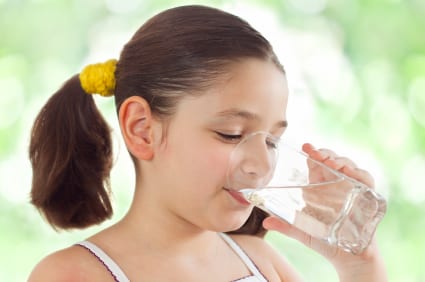If you are looking for facts about how much water to drink per day, we’ve got some statistics that will help!
Whether it is summer or winter (or something in between) it is important that adults and children keep hydrated and drink enough water each day.
Keeping our kids hydrated and encouraging them to drink more water is essential to ensure they are fit, strong and healthy to enjoy school each day and especially throughout the hot summer months.
Why do we need water?
Water is essential for life and is one of the healthiest ways to hydrate. Water makes up about 50-80 per cent of your lean body mass.
As well as helping to maintain the balance of essential minerals, your body needs adequate water to help with:
- Temperature regulation, especially keeping you cool by allowing you to sweat when you get hot.
- Digestion and processing of food, by keeping your gastrointestinal tract moist to aid in the passing of the food through the gut.
- Absorption of nutrients and helping you to pass waste.
How much water to drink – kids?
One in 10 (9.4%) of 7-9 year olds surveyed believed that the body can survive without water.
Staying well hydrated is even more important for children as they are at greater risk of dehydration than adults due to their higher surface-to-body weight ratio and smaller reserves of body fluids.
Despite water being freely available in schools, only half (51%) of children questioned said they thought that they should drink more water at school, with four in ten (40%) having to be told to drink water by their parents. More than a third (35.1%) do not drink water when thirsty and over 40% (42.4%) don’t drink water whilst playing sport or exercising.
We’re constantly losing water from our bodies, primarily via urine and sweat. There are many different opinions on how much water we should be drinking every day. So how many litres of water should we drink a day? Most experts suggest that we should drink eight 8-ounce glasses of water a day. This is roughly equivalant to 2 litres of water a day.
However, there are other health gurus who think we’re always on the brink of dehydration and that we need to sip on water constantly throughout the day… even when we’re not thirsty. As with most things, this depends on the individual and there are many factors (both internal and external) that ultimately affect our need for water, including our weight, gender and where we live for example.
Do Other Fluids Count Toward Your Total?
Plain water is not the only thing that contributes to fluid balance, other drinks and foods can also have a significant effect. One myth is that caffeinated drinks (like coffee or tea) don’t count because caffeine is a diuretic. However, the studies show that this isn’t true, because the diuretic effect of these beverages is very weak (22).
Most foods are also loaded with water. Meat, fish, eggs and especially water-rich fruits and vegetables all contain significant amounts of water. If you drink coffee or tea and eat water-rich foods, then chances are that this alone is enough to maintain fluid balance, as long as you don’t sweat much.
Families Magazine’s Tips to encourage children to drink more water:
Here are our top tips for getting more water into your kids.
Make water more fun
1. Help your children to drink more water and decorate their own personalised water bottle. Make them as cheeky as possible so they feel ownership over their own drinking habits.
2. Ask your child to count how many bottles or cups of water your family drink each day. They’ll be surprised at how the numbers rack up and it can turn something mundane into a fun game.
3 Fun ice cubes can make a drink of water into an adventure. Fill an ice tray with slices of strawberries, grapes, blueberries or raspberry before putting it in the freezer. Add to cups of water when desired.
Experiment with water
4. Try this experiment: cut up an apple and weigh the slices, then leave them out on a plate uncovered for a week. Each day, weigh the apple slices and record the weight. Ask your children to think about why it loses weight as it dries up and they’ll soon start thinking about the importance of water.
5. Demonstrate how a wilting plant, such as a basil plant, will perk up fairly rapidly once it has water to rehydrate its cells.
Help with water drinking habit forming
6. We know that children copy their parents’ behaviour, so make sure you get into the habit of drinking water in front of your children.
7. Repeated tastings of water may help kids to develop a taste for it. To make it more fun you could add ice, a slice of lemon or a curly straw.



#6 is a big one. Our child is only 3 and I have to keep telling him to drink water. Then he takes a tiny sip and I have to tell him to drink more. He sees us drink and wants to have what we’re having.
Yes! Role modelling so important as a parent – we can ‘tell’ them what ever we like, but what we ‘show’ them is what will stick in their minds and become their actions!